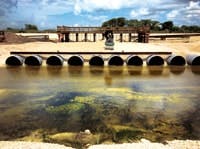According to the Plastics Pipe Institute Inc. (PPI), a relatively new type of large-diameter polyolefin pipe is playing a pivotal role in the restoration of the Everglades.
The water control project used 10 runs each of 100 ln ft of 60-in.-diameter polypropylene storm pipe in a structure equipped with vertical lift gates to provide east/west drainage through a levee. The unit has a maximum combined flow of 750 cu ft per second with velocities up to 1.8 in. per second to allow for pulse releases. Officially called the Water Conservation Area 3 Decompartmentalization & Sheetflow Enhancement Hydrologic Field Test L-67A Levee & Turn-Around project, it performed as intended, and more of these systems will be installed along the entire levee.
“This is a significant ecological endeavor made possible by plastic pipe,” said Tony Radoszewski, president of PPI. “No other pipe could provide the long life, ease of installation, low-impact delivery plus the watertight joints or the strength needed.”
The project was awarded the 2013 Project of the Year award by PPI’s Corrugated Plastic Pipe Div. (CPPA). Radoszewski made the presentation to PPI member companies Advanced Drainage Systems Inc. (ADS), the pipe manufacturer, and HD Supply Waterworks, the distributor, during the association’s annual meeting in May 2014 in Palm Springs, Calif.
The pipe, called ADS HP (high-performance) storm pipe, was used to build the prototype along a 3,000-ft stretch of levees and canals to determine how best to design and formulate plans for future Comprehensive Everglades Restoration Plan (CERP) projects. The purpose of the plan is to restore and preserve south Florida’s natural ecosystems while enhancing water supplies and maintaining flood control.
“The history of this area is fascinating,” Radoszewski said. “Most people would not be living in South Florida if it were not for the Central & Southern Florida Project [C&SF Project]. Prior to the turn of the last century, the small number of people who lived in southern Florida were restricted to building on high ground near the coastal and central Florida ridges. It simply was too wet in the interior much of the time to live there.”
According to Radoszewski, after devastating hurricanes in the late 1920s and late 1940s, citizens and elected officials of Florida petitioned Congress to control the floodwaters. “At the time, it seemed like the right thing to do. The C&SF Project was authorized by Congress in 1948, and the U.S. Army Corps of Engineers and the South Florida Water Management District constructed the most elaborate and effective water management system in the world,” Radoszewski said. “But eventually the project negatively affected the Everglades and the south Florida ecosystem. Now a new plan is underway to restore the ecosystem and meet south Florida’s water needs for the next 50 years. This sluice structure is just one important step.”
Located in Miami-Dade County, it was designed to address scientific, water flow and water management uncertainties that require clarification prior to future planning and construction of Everglades restoration projects, authorized in the Water Resources Development Act of 2000.
“The strength of the plastic pipe was critical,” said Daniel Currence, P.E., director of engineering for PPI’s CPPA division. “To control the water flow, large pipe had to be used. It was a 60-in.-diameter pipe used under 14 ft of cover.” The structure itself is a creative way to control water flow in an environmentally sensitive area. The pipe provided a cost-effective,
long-life solution. It also had the watertight seals desired by the U.S. Army Corps of Engineers. Additionally, the terrain posed another problem with delivery of product along a single-lane, 7-mile-long road. The 20-ft-long sections of lightweight pipe reduced the number of truckloads compared to the number that would be needed to deliver 8-ft sections of RCP, which can weigh more than 10,000 lb. This lowered the carbon footprint and reduced wear and tear on roads in the area.
“The pipe couples advanced polypropylene resin technology with a proven, dual-wall-profile design for superior performance and durability,” Currence said. “The smooth interior wall offers additional strength and superior flow. It meets or exceeds typical standards for pipe stiffness and joint integrity, and meets ASTM F2736, ASTM F2881 and AASHTO M330 for the respective diameters.” Additionally, polypropylene pipe is approved for use by the U.S. Army Corps of Engineers for storm drainage applications under Section 33 40 00 of the Unified Facilities Guide Specifications and has been rated with a 100-year useful life by the Florida Department of Transportation. “It all adds up to a very strong structure that will perform for a lifetime under extreme conditions, even hurricanes,” Currence said.
“By restoring east/west drainage using this structure, the natural ecosystem of the Everglades will be restored while maintaining flood control as designed in the original Everglades project in 1948,” Radoszewski said. “We were pleased to present the Project of the Year award to our member companies, ADS and HD Supply Waterworks, for this excellent example of the durable use of large-diameter polyolefin pipe.”
Download: Here

